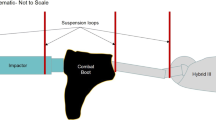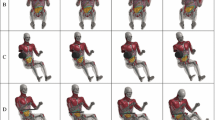Abstract
Current military conflicts are characterized by the use of the improvised explosive device. Improvements in personal protection, medical care, and evacuation logistics have resulted in increasing numbers of casualties surviving with complex musculoskeletal injuries, often leading to life-long disability. Thus, there exists an urgent requirement to investigate the mechanism of extremity injury caused by these devices in order to develop mitigation strategies. In addition, the wounds of war are no longer restricted to the battlefield; similar injuries can be witnessed in civilian centers following a terrorist attack. Key to understanding such mechanisms of injury is the ability to deconstruct the complexities of an explosive event into a controlled, laboratory-based environment. In this article, a traumatic injury simulator, designed to recreate in the laboratory the impulse that is transferred to the lower extremity from an anti-vehicle explosion, is presented and characterized experimentally and numerically. Tests with instrumented cadaveric limbs were then conducted to assess the simulator’s ability to interact with the human in two mounting conditions, simulating typical seated and standing vehicle passengers. This experimental device will now allow us to (a) gain comprehensive understanding of the load-transfer mechanisms through the lower limb, (b) characterize the dissipating capacity of mitigation technologies, and (c) assess the bio-fidelity of surrogates.









Similar content being viewed by others
References
Bir, C., A. Barbir, F. Dosquet, M. Wilhelm, M. van der Horst, and G. Wolfe. Validation of lower limb surrogates as injury assessment tools in floor impacts due to anti-vehicular land mines. Mil. Med. 173:1180–1184, 2008.
Bird, R. Protection of vehicles against landmines. J. Battlefield Technol. 4:14–17, 2001.
Cartner, J. L., Z. M. Hartsell, W. M. Ricci, and P. I. Tornetta. Can we trust ex vivo mechanical testing of fresh-frozen cadaveric specimens? The effect of postfreezing delays. J. Orthop. Trauma 25:459–461, 2011.
Crandall, J. R., D. Bose, J. Forman, C. D. Untaroiu, C. Arregui-Dalmases, C. G. Shaw, and J. R. Kerrigan. Human surrogates for injury biomechanics research. Clin. Anat. 24:362–371, 2011.
Funk, J. R., J. R. Crandall, L. J. Tourret, C. B. MacMahon, C. R. Bass, J. T. Patrie, N. Khaewpong, and R. H. Eppinger. The axial injury tolerance of the human foot/ankle complex and the effect of Achilles tension. J. Biomech. Eng. 124:750–757, 2002.
Ludema, K. Friction, Wear, Lubrication: A Textbook in Tribology. New York, NY: CRC Press, 1996.
Manoli, A., P. Prasad, and R. Levine. Foot and Ankle Severity Scale (FASS). Foot Ankle Int. 18:598–602, 1997.
McKay, B., and C. Bir. Lower extremity injury criteria for evaluating military vehicle occupant injury in underbelly blast events. Stapp Car Crash J. 53:229–249, 2009.
McMaster, J., M. Parry, W. Wallace, L. Wheeler, C. Owen, R. Lowne, C. Oakley, and A. Roberts. Biomechanics of ankle and hindfoot injuries in dynamic axial loading. Stapp Car Crash J. 44:357–377, 2000.
Peleg, K., L. Aharonson-Daniel, M. Stein, M. Michaelson, Y. Kluger, D. Simon, Israeli Trauma Group (ITG), and E. K. Noji. Gunshot and explosion injuries: characteristics, outcomes, and implications for care of terror-related injuries in Israel. Ann. Surg. 239:311–318, 2004.
Ramasamy, A., S. E. Harrisson, J. C. Clasper, and M. P. M. Stewart. Injuries from roadside improvised explosive devices. J. Trauma 65:910–914, 2008.
Ramasamy, A., A. M. Hill, A. E. Hepper, A. M. J. Bull, and J. C. Clasper. Blast mines: physics, injury mechanisms and vehicle protection. J. R. Army Med. Corps 155:258–264, 2009.
Ramasamy, A., A. M. Hill, S. Masouros, I. Gibb, A. M. J. Bull, and J. C. Clasper. Blast-related fracture patterns: a forensic biomechanical approach. J. R. Soc. Interface 8:689–698, 2011.
Ramasamy, A., A. M. Hill, R. Phillip, I. Gibb, A. M. J. Bull, and J. C. Clasper. The modern “deck-slap” injury—calcaneal blast fractures from vehicle explosions. J. Trauma 71:1684–1688, 2011.
Turegano-Fuentes, F., P. Caba-Doussoux, J. Jover-Navalon, E. Martin-Perez, D. Fernandez-Luengas, L. Diez-Valladares, D. Perez-Diaz, P. Yuste-Garcia, H. Guadalajara Labajo, R. Rios-Blanco, F. Hernando-Trancho, F. Garcia-Moreno Nisa, M. Sanz-Sanchez, C. Garcia-Fuentes, A. Martinez-Virto, J. Leon-Baltasar, and J. Vazquez-Estevez. Injury patterns from major urban terrorist bombings in trains: the Madrid experience. World J Surg. 32:1168–1175, 2008.
van der Horst, M. J., C. K. Simms, R. Maasdam, and P.-J. C. Leerdam. Occupant lower leg injury assessment in landmine detonations under a vehicle. In: IUTAM Symposium on Impact Biomechanics: From Fundamental Insights to Applications, Edn 124, edited by M. D. Gilchrist. The Netherlands: Springer, 2005, pp. 41–49.
Wang, J. J., R. Bird, B. Swinton, and A. Krstic. Protection of lower limbs against floor impact in army vehicles experiencing landmine explosion. J. Battlefield Technol. 4:8–12, 2001.
Yoganandan, N., F. A. Pintar, M. Boyton, and P. Begeman. Dynamic axial tolerance of the human foot–ankle complex. In: 40th Stapp Car Crash Conference Proceedings, 1996, pp. 207–218.
Acknowledgments
The authors would like to express their appreciation to Northern Hydraulic Cylinder Engineers Ltd. for the construction of AnUBIS, and Warrant Officer Rachel Mackenzie MBE in Queen Elizabeth Hospital, Birmingham for operating the CT scanner out of office hours. The costs for the construction and design of the rig were covered by the Army Benevolent Fund (ABF)—The Soldiers’ Charity; the Soldiers, Sailors, Airmen and Families Association (SSAFA) Forces Help; the FH Muirhead Charitable Trust; the Drummond Foundation; and the Defence, Science and Technology Laboratory (Dstl). The financial support of the Defence Medical Services (DMS) for AR, TJB, AMH, ATHW, and JCC, of the Royal Centre for Defence Medicine (RCDM) for the acquisition of equipment and consumables, of BBSRC for NN, and of Dstl and ABF—The Soldiers’ Charity for SDM are kindly acknowledged.
Author information
Authors and Affiliations
Corresponding author
Additional information
Associate Editor Stefan M Duma oversaw the review of this article.
Electronic supplementary material
Below is the link to the electronic supplementary material.
Supplementary material 1 (WMV 8237 kb)
Appendix: Calculation of the Adiabatic Expansion
Appendix: Calculation of the Adiabatic Expansion
For an adiabatic gas expansion, the pressure falls according to the equation
where p is the pressure, V is the internal volume of the pressure vessel, h is the depth of the vessel, γ is the adiabatic index, and the subscript o implies the original, fully pressurized state.
Volume, \( V = V_{\text{o}} + hA = V_{\text{o}} + h\frac{\pi }{4}D^{2} \)
Rights and permissions
About this article
Cite this article
Masouros, S.D., Newell, N., Ramasamy, A. et al. Design of a Traumatic Injury Simulator for Assessing Lower Limb Response to High Loading Rates. Ann Biomed Eng 41, 1957–1967 (2013). https://doi.org/10.1007/s10439-013-0814-6
Received:
Accepted:
Published:
Issue Date:
DOI: https://doi.org/10.1007/s10439-013-0814-6




